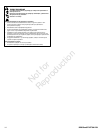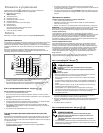
5
en
WARNING
Fuel and its vapors are extremely flammable and explosive.
Fire or explosion can cause severe burns or death.
When Adding Fuel
Turn engine off and let engine cool at least 2minutes before removingt he fuel
cap.
Fill fuel tank outdoors or in well -ventilated area.
Do not overfill fuel tank. To allow for expansion of the fuel, do not fill above the
bottom of the fuel tank neck.
Keep fuel awayfrom sparks, open flames,pilot lights, heat, and otherignition
sources.
Check fuel lines, tank, cap, and fittings frequently for cracks or leaks.
Replace if necessary
If fuel spills, wait until it evaporates before starting engine.
When Starting Engine
Ensure that spark plug, muffler, fuel cap and air c leaner (if equipped) are in
place and secured.
Do not crank engine with spark plug removed.
If engine floods, s et choke (if equipped) to OPEN/RUN position, move throttle
(if equipped) to FAST position and crank until engine starts.
When Operating Equipment
Do not tip engine or equipment at angle which causes fuel to spill.
Do not choke the carburetor to stop engine.
Never start or run the engine with the air cleaner assembly (if equipped) or the
air filter (if equipped) removed.
When Changing Oil
When you drain the oil from the top oil fill tube, the fuel tank must be empty or
fuel can leak out and result in a fire or explosion.
When Tipping Unit for Maintenance
When performing maintenance that requires the unit to be tipped, the fuel tank
must be empty or fuel can leak out and result in a fire or explosion.
When Transporting Equipment
Transport with f uel tank EMPTY or with fuel shut-off valve OFF.
When Storing Fuel Or Equipment With Fuel In Tank
Store away from furnaces, stoves, water heaters or other appliances that have
pilot lights or other ignition sources because they can ignite fuel vapors.
Starting engine creates sparking.
Sparking can ignite nearby flammable gases.
Explosion and fire could result.
WARNING
If there is natural or LP gas leakage in area, do not start engine.
Do not use pressurized starting fluids because vapors are flammable.
POISONOUS GAS HAZARD. Engine exhaust contains carbon
monoxide, a poisonous gas that could kill you in minutes. You
CANNOT see it, smell it, or taste it. Even if you do not smell exhaust
fumes, you could still be exposed to carbon monoxide gas. If you start
to feel sick, dizzy, or weak while using this product, shut it off and get
to fresh air RIGHT AWAY. See a doctor. You may have carbon
monoxide poisoning.
WARNING
Operate this product ONLY outside far away from windows, doors and vents to
reduce the risk of carbon monoxide gas from accumulating and potentially being
drawn towards occupied spaces.
Install battery--operated carbon monoxide alarms or plug--in carbon monoxide
alarms with battery back-up according to the manufacturer’s instructions.
Smoke alarms cannot detect carbon monoxide gas.
DO NOT run this product inside homes, garages, basements, crawlspaces,
sheds, or other partially-enclosed spaces even if using fans or opening doors
and windows for ventilation. Carbon monoxide can quickly build up in these
spaces and can linger for hours, even after this product has shut off.
ALWAYS place this product downwind and point the engine exhaust away from
occupied spaces.
Rapid r etraction of starter cord (kickback) will pull hand and arm
toward engine faster than you can let go.
Broken bones, fractures, bruises or sprains could result.
WARNING
When starting engine, pull the starter cord slowly until resistance is felt and then
pull rapidly to avoid kickback.
Remove all external equipment/engine loads before starting engine.
Direct-coupled equipment components such as, but not limited to, blades,
impellers, pulleys, sprockets, etc., must be securely attached.
Rotating parts can contact or entangle hands, feet, hair, clothing, or
accessories.
Traumatic amputation or severe laceration can result.
WARNING
Operate equipment with guards in place.
Keep hands and feet away from rotating parts.
Tie up long hair and remove jewelry.
Do not wear loose-fitting clothing, dangling drawstrings or items that could
become caught.
Running engines produce heat. Engine parts, especially muffler,
become extremely hot.
Severe thermal burns can occur on contact.
Combustible debris, such as leaves, grass, brush, etc. can catch fire.
WARNING
Allow muffler, engine cylinder and fins to cool before touching.
Remove accumulated debris from muffler area and cylinder area.
It is a v iolation of California Public Resource Code, Section 4442, to use or
operate the engine on any forest-covered, brush-covered, or grass-covered land
unless the exhaust system is equipped with a spark arrester, as defined in
Section 4442, maintained in effective working order. Other states or federal
jurisdictions may have similar laws. Contact the original equipment
manufacturer, retailer, or dealer to obtain a spark arrester designed for the
exhaust system installed on this engine.
Unintentional sparking can result in fire or electric shock.
Unintentional start-up can result in entanglement, traumatic
amputation, or laceration.
Fire hazard
WARNING
Before performing adjustments or repairs:
Disconnect the spark plug wire and keep it away from the spark plug.
Disconnect battery at negative terminal (only engines with electric start.)
Use only c orrect tools.
Do not tamper with governor spring, links or other parts to increase engine
speed.
Replacement parts must be of the same design and installed in the same
position as the original parts. Other parts may not perform as well, may damage
the unit, and may result in injury.
Do not strike the flywheel with a hammer or hard object because the flywheel
may later shatter during operation.
When testing for spark:
Use approved spark plug tester.
Do not check for spark with spark plug removed.
Not for
Reproduction


















